Homemade Pizza Dough
- By Jennifer Segal
- Updated January 20, 2025
- 219 Comments
- Leave a Review

This post may contain affiliate links. Read my full disclosure policy.
Why settle for store-bought when you can make your own pizza dough in just 20 minutes? This foolproof pizza dough recipe delivers a crispy, chewy crust every time—plus, it’s freezer-friendly for whenever the craving strikes!

If you’re looking for the perfect crust for homemade pizza, making your own dough is the way to go. With just five simple ingredients, you can whip up a batch in just 20 minutes. The key is to plan ahead—you’ll need to allow at at least 90 minutes for the dough to rise in a warm, draft-free spot before using it.
This recipe makes two pounds of dough, enough for two large pizzas, four individual ones, two stromboli, or four calzones. You can prepare it up to two days ahead, and it freezes beautifully for future meals!
“I’ve made many pizza doughs and this is by far the easiest yet tastiest dough ever!”
What you’ll need to make Homemade pizza dough
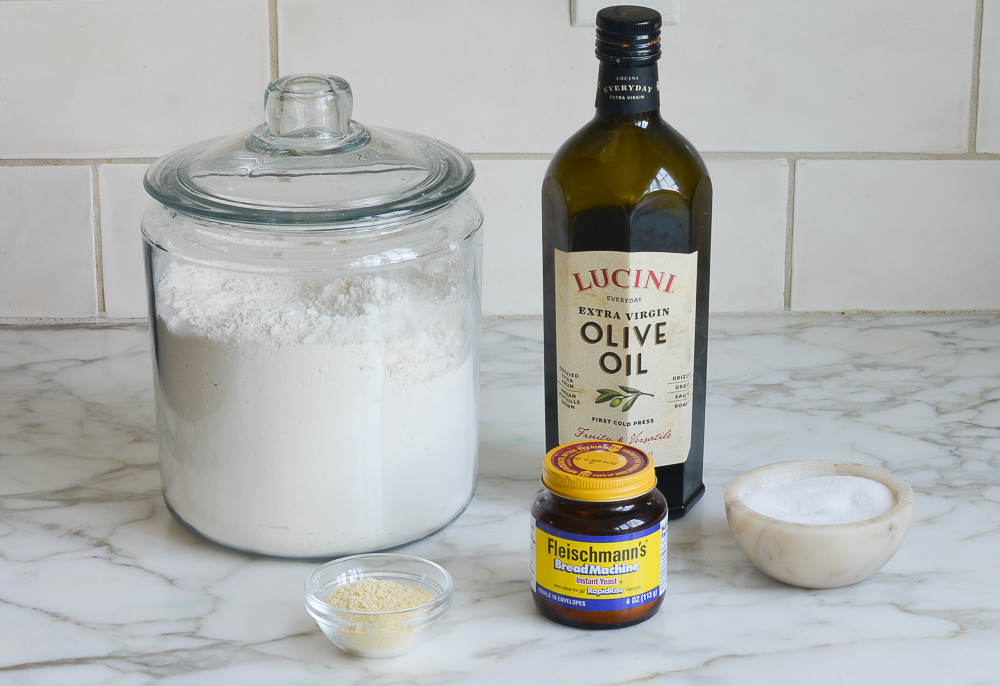
- All-Purpose Flour: Forms the base of the dough.
- Extra-virgin Olive Oil: Adds richness to the dough and helps it crisp up in the oven.
- Salt: A healthy dose is added for flavor.
- Cornmeal: Used to dust the baking sheet and keep the dough from sticking as it bakes; it also gives the crust a bit of extra crispiness and flavor.
- Yeast: It’s what makes the dough rise! I like to use instant yeast, which you might also see labeled as rapid-rise, quick-rise, or even bread machine yeast (I know, it’s confusing—but they’re all the same thing). If you only have active dry yeast, also known as regular yeast, that works too—just keep in mind it’ll take about 50% longer for the dough to rise.
- Jump to the printable recipe for precise measurements
Step-By-Step Instructions
To begin, combine the flour, yeast, and salt in the bowl of a stand mixer.

Stir with a spoon to combine, and then add the oil and warm water.
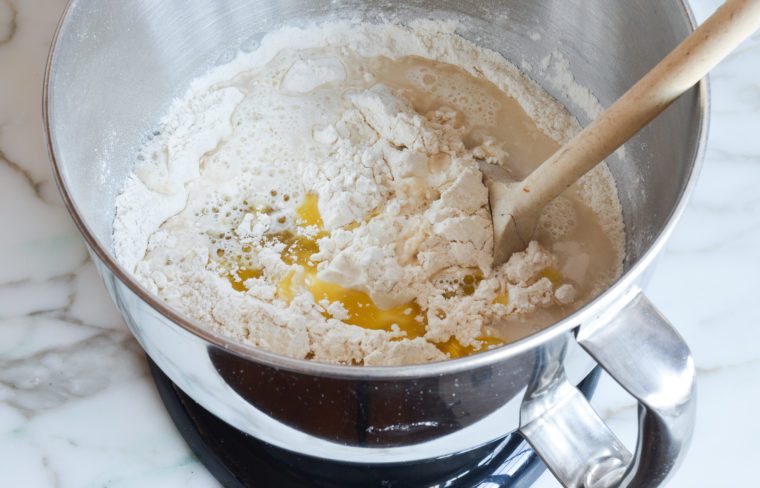
Stir until the dough comes together into a shaggy mass.
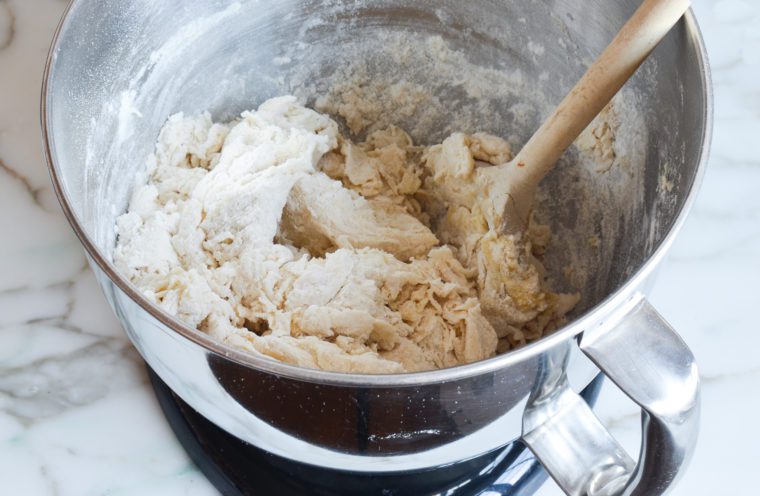
Fit the mixer with the dough hook and knead on medium-low speed until the dough is smooth and elastic, 5 to 7 minutes. (Alternatively, you can knead the dough by hand.)
Transfer the dough to a lightly oiled large bowl. Cover the bowl with plastic wrap or a damp kitchen towel, and let the dough rise in a warm place until it has doubled in size, 1 to 2 hours.
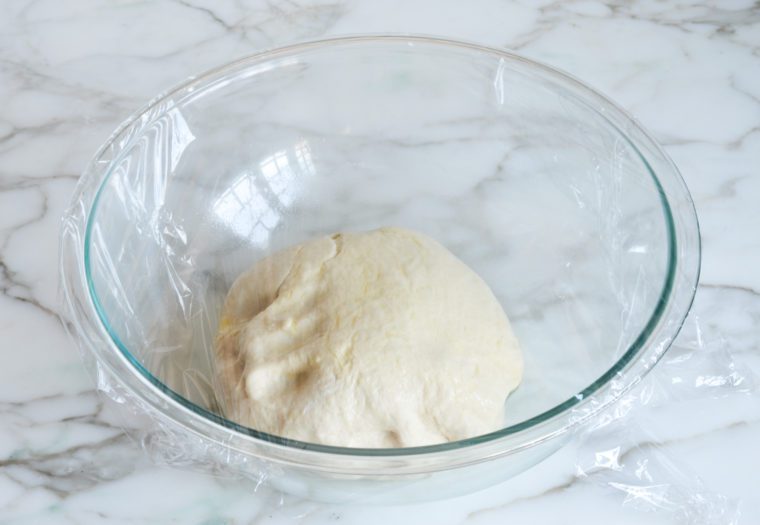
There are plenty of great spots to let your dough rise—try a sunny spot, near a heating vent in colder months, or even on top of a warm appliance like your fridge. If your oven has a proof setting, use it! No proof setting? Just turn on the oven light; it creates just enough warmth for a perfect rise.
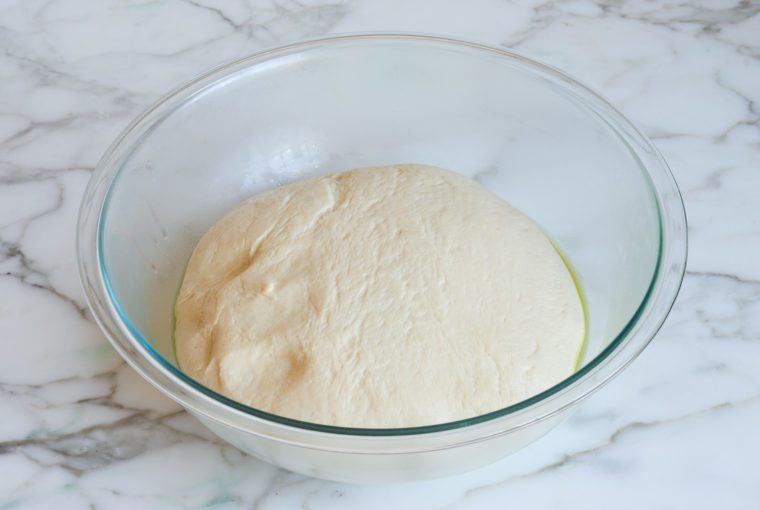
Once the dough has risen, punch it down and turn it out onto a lightly floured surface. Cut it in half and roll each piece into a ball. Cover the dough with a damp kitchen towel and let it rest for 15 to 20 minutes.
If you’re not using the dough right away, lightly coat the balls with olive oil, place them in freezer bags, and squeeze out all the air before sealing. They’ll keep in the fridge for up to 2 days or in the freezer for up to 3 months. When you’re ready to use the dough, thaw if necessary, and let it sit at room temperature for about 30 minutes.
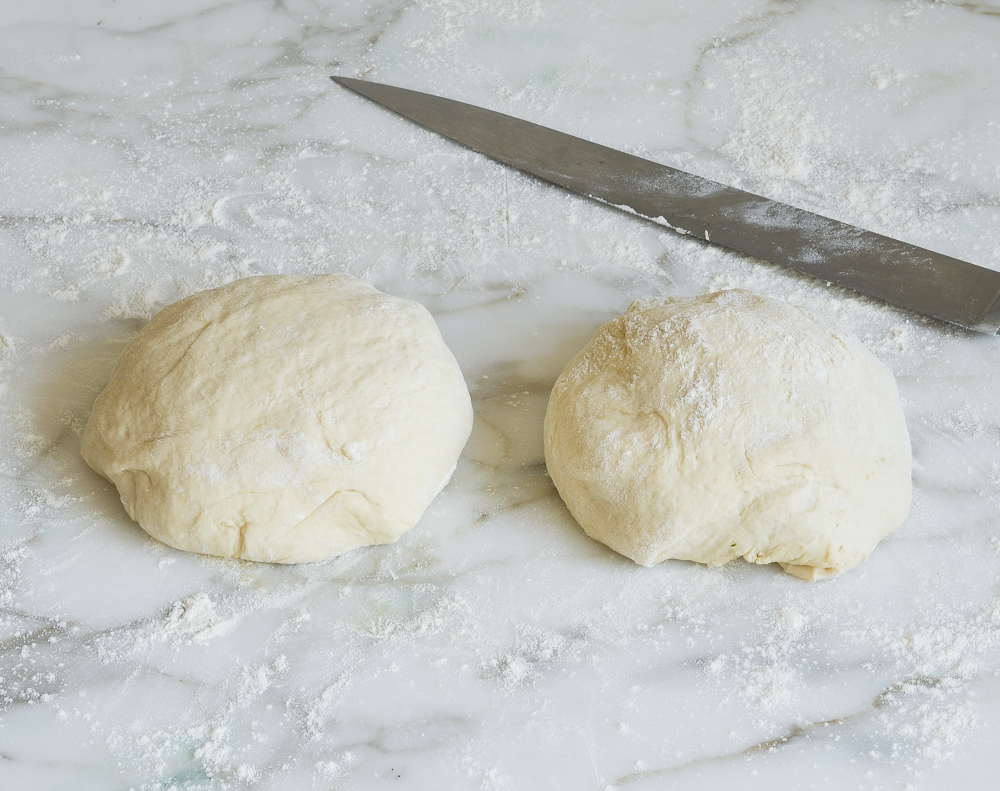
When it comes time to shape the pizza dough for baking, you can stretch it into any shape, size, or thickness you like (just keep in mind that a thicker crust will take longer to bake). Simply press and stretch the dough using your hands, dusting with more flour if necessary.
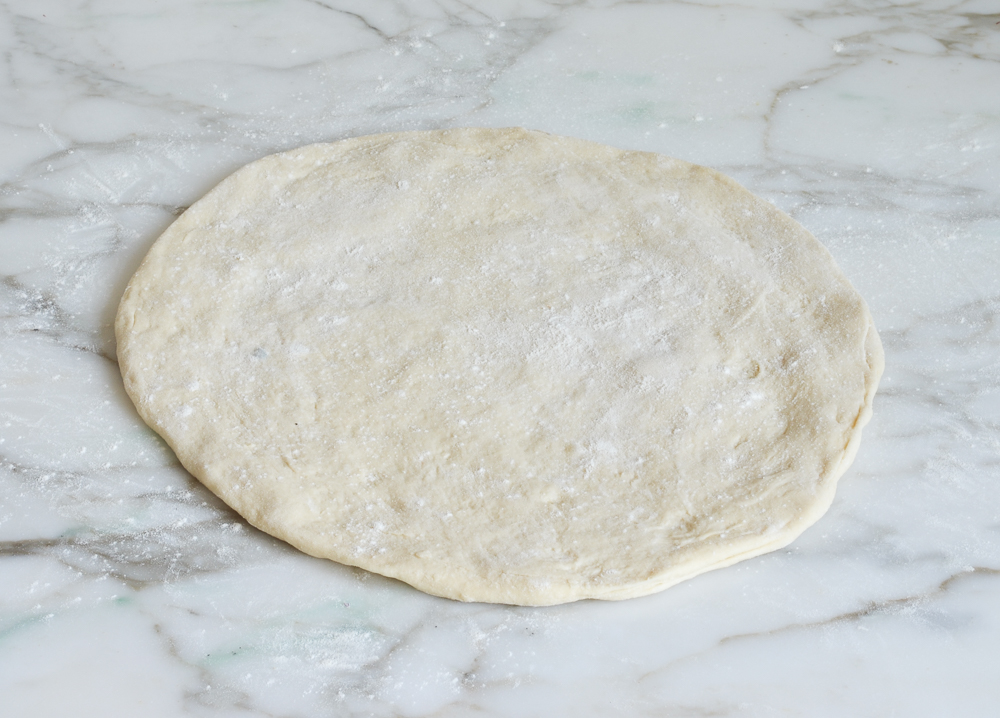
Baking Instructions

Every pizza recipe is a little different, but as a general guideline:
- Preheat the oven to 500°F and set an oven rack in the bottom position. Dust a 13×18-inch baking sheet lightly with cornmeal.
- Place the stretched dough on the baking sheet, and gently stretch it out again so that it maintains its shape.
- Spread your sauce over the dough, leaving a 1/2-inch border around the edges. Slide the baking sheet into the oven and bake for 5 to 7 minutes, until the crust is partially cooked. Remove from the oven and scatter the cheese and toppings over the sauce. Slide the pan back into the oven and cook until the crust is golden brown and the cheese is melted and bubbling, 4 to 6 minutes more.
Video Tutorial
You May Also Like
Homemade Pizza Dough

Homemade pizza dough is easier than you think! With just a handful of ingredients and a little rise time, you’ll be ready to stretch, bake, and enjoy.
Ingredients
- 4 cups all-purpose flour, spooned into measuring cup and leveled-off, plus more for dusting
- 1 tablespoon instant/quick-rise yeast
- 2¼ teaspoons salt
- ¼ cup extra-virgin olive oil
- 1¼ cups plus 2 tablespoons warm water (see note)
- Cornmeal, for dusting the pan before baking
Instructions
- Combine the flour, yeast, and salt in the bowl of a stand mixer. Stir with a spoon to combine. Add the oil and water and stir until the dough comes together into a shaggy mass. Fit the stand mixer with the dough hook and knead on medium-low speed until the dough is smooth and elastic, 5 to 7 minutes. (Alternatively, you can knead the dough by hand.) The dough should be slightly tacky and cling just to the bottom of the bowl; if it seems too dry during the kneading process, add 1 tablespoon of water. If it seems too sticky, add 1 tablespoon of flour.
- Dust your hands with flour, then gather the dough into a ball and transfer it to a lightly oiled large bowl. Cover the bowl with plastic wrap or a damp kitchen towel and let the dough rise in a warm place until it has doubled in size, 1 to 2 hours.
- When the dough has risen, punch it down and place on a lightly floured surface. Cut the dough in half and roll each piece into a ball. (If you're not planning to use the dough right away, see the make-ahead/freezing instructions below.)
- Cover the dough balls with a damp kitchen towel and let rest for 15 to 20 minutes (the dough will rise a bit). Using your hands, stretch the dough to the desired shape. Proceed with your pizza recipe, or follow the general baking instructions below.
General Baking Instructions
- Preheat the oven to 500°F and set an oven rack in the bottom position. Dust a 13x18-inch baking sheet lightly with cornmeal. Place the stretched dough on the baking sheet, and gently stretch it out again so that it maintains its shape. Spread your sauce over the dough, leaving a ½-inch border around the edges. Slide the baking sheet into the oven and bake for 5 to 7 minutes, until the crust is partially cooked. Remove from the oven and scatter the cheese and toppings over the sauce. Slide the pan back into the oven and cook until the crust is golden brown and the cheese is melted and bubbling, 4 to 6 minutes more. Remove the pizza from the oven and transfer to a cutting board. Slice and serve.
- Note: Active dry yeast may be used instead of instant yeast, however the dough will take longer to rise. To give active dry yeast a boost, you can dissolve it in the warm water and let it sit until frothy, about 10 minutes. Following that, add it to the mixing bowl with the flour, oil, and salt and proceed with the recipe.
- Note: The water should be warm to the touch — not hot — as anything over 130°F will kill the yeast and keep the dough from rising. It’s not necessary to measure the temperature, but you’re aiming for around 105°F.
- Make-Ahead/Freezing Instructions: After step 3, lightly coat the dough balls with olive oil. Place into freezer bags and seal shut, squeezing out all the air. Refrigerate for up to 2 days or freeze for up to 3 months. When you're ready to use, thaw overnight in the fridge if frozen. Whether refrigerated or frozen, let the dough sit at room temperature for 30 minutes before stretching.
See more recipes:
Comments
Add a Comment Cancel reply
This site uses Akismet to reduce spam. Learn how your comment data is processed.
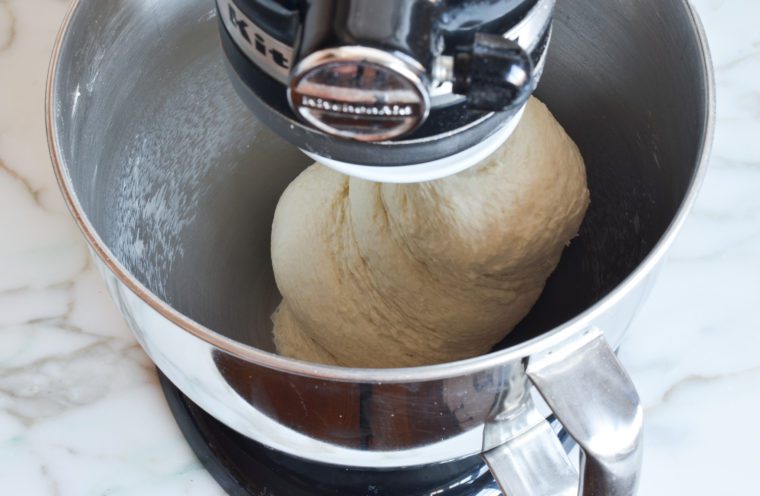

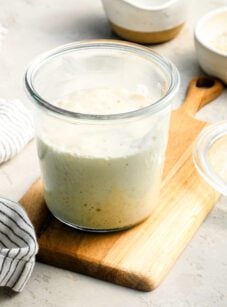



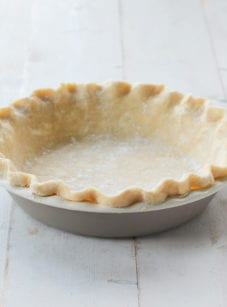


Great recipe! Baking the dough for a few minutes with just the sauce is a game changer! Thank You!!!!!
Does this work with gluten free flour?
Hi Darlene, I’ve only made this with all-purpose flour, so I can’t say for sure how it will work with gluten-free — I’m sorry! I’d love to hear how it turns out if you try it!
Best dough, I’ve ever tried. Thank you!
Could you please add the gram measurements to the recipe?
Plus, I have three kinds of all purpose flour that vary in protein content! Going to try this with the Trader Joes AP.
Hi Ann, the great majority of my recipes (including this one) include conversions to metric/weight measurements. To view them, scroll down to the recipe and immediately below the recipe title on the right side, you’ll see a small toggle. If you switch it from “cup measures” to metric, you’ll see measurements that will work for you. Hope that helps!
I have 2 questions. If I make the dough a day ahead can I let the dough balls rise on a cookie sheet covered with a damp towel or should it be wrapped in plastic?
Have you ever used this to make pizza on the grill?
Hi Ann, I would wrap the dough balls in plastic. And I’ve never made pizza on the grill, but a number of readers have commented that they have successfully. Hope you enjoy!
Could I use this do after storing one week in the fridge?
I don’t recommend it – sorry!
The recipe calls for 1 tablespoons of yeast and 2 1/4 tsp salt. Should this be reversed?
Hi John, those measurements are correct. That amount of salt may sound like a lot, but it’s needed for flavor.
Hi Jenn
Could I use vegetable oil or canola oil instead of olive?
Sure, vegetable oil should work.
Hi Jenn!
I love your recipes and I can’t wait to try this pizza dough. I did have a question on the temperature. I have a Breville smart oven and the “pizza” function only goes up to 450 degrees. Can you let me know how you would bake the pizza dough based off of this temp and not the 500 degrees you have motioned? I’m a big fan (and from Buffalo!) thank you in advance for your help!
Mel
Hi Melanie, thanks for your nice words about the recipes – so glad you like them! If your oven temp only goes up to 450°F, the dough/pizza will just take a bit longer to bake; not much longer though so keep a close eye on it. Enjoy!